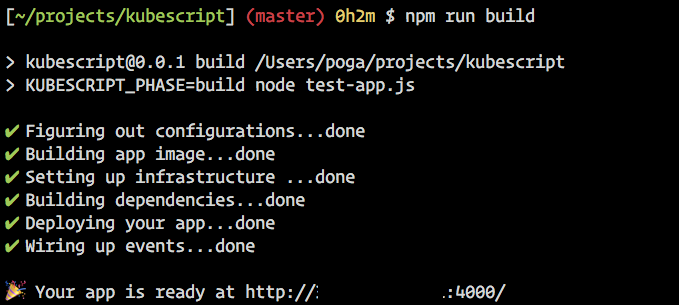KubeScript is a web application framework that helps you build scalable web application with plain JavaScript, connect with microservices written in any language.
npm i kubescript
const App = require('kubescript')
// require docker images directly
const redisConfig = require('docker://redis')
const redisClient = require('redis')
let app = new App()
app.post('/register', function (ctx) {
let {host, port} = redisConfig
let c = redisClient.createClient({host, port})
register(c)
app.emit('user.registered')
ctx.body = 'bar'
})
// event handling
app.on('user.registered', function (ctx) {
})
app.run()Deploy this application to kubernetes with KUBESCRIPT_PHASE=build node index.js. One command, everything is automated.
For more example, see test-app.js.
To start, you need the following tools installed on your computer:
- docker
- kubectl
- conduit
You also need a working kubernetes cluster. Currently, only v1.9.7 is tested.
note: When using GKE, you need to create a role first:
kubectl create clusterrolebinding cluster-admin-binding-$USER --clusterrole=cluster-admin --user=$(gcloud config get-value account).
$ npx ks add foobar@1.2.3
const App = require('kubescript')
let app = new App()Create a new KubeScript application.
Create a HTTP endpoint for specified method. handler is a koa handler.
Routing is done with koa-router.
Subscribe to an event.
Emit an event with given payload.
If KUBESCRIPT_PHASE environment variable is set to build, it will start building your application.
If not, start the application for runtime.
You need to add settings to your package.json. Here's an example:
{
"name": "YOUR_APP_NAME",
"version": "0.0.1",
...
"license": "ISC",
"dependencies": {
...
},
"KubeScript": {
"prefix": "gcr.io/spacer-184617/",
"dependencies": {
"foobar": {
"version": "latest",
"ports": [
{
"name": "http-server",
"containerPort": 3000
}
]
},
"redis": {
"version": "4.0.9"
}
}
},
}KubeScript.prefix: The string to prepend to your application's docker image name. This is for pushing your image to the correct registry, such as Google Container Registry.KubeScript.dependencies: The microservices your application depends on. The key is the corresponding docker image name. The value includes:version: The version you want to use. KubeScript will look for image with specified version tag.ports: The service's exposed port. KubeScript will try to find theEXPOSEport via inspecting the docker image by default.
The MIT License

